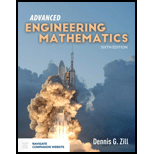
Advanced Engineering Mathematics
6th Edition
ISBN: 9781284105902
Author: Dennis G. Zill
Publisher: Jones & Bartlett Learning
expand_more
expand_more
format_list_bulleted
Question
Chapter 14.1, Problem 23E
To determine
The steady state temperature of the annular plate with the boundary condition.
Expert Solution & Answer
Want to see the full answer?
Check out a sample textbook solution
Students have asked these similar questions
Using Karnaugh maps and Gray coding, reduce the following circuit represented as a table and write the final circuit in simplest form (first in terms of number of gates then in terms of fan-in of those gates).
Consider the alphabet {a, b, c}.• Design a regular expression that recognizes all strings over {a, b, c} that have at least three nonconsec-utive c characters (two characters are non-consecutive if there is at least one character between them)and at least one a character.• Explain how your regular expression recognizes the string cbbcccac by clearly identifying which partsof the string match to the components of your regular expression
Complex Analysis 2
z3+3
Q1: Evaluate cz(z-i)²
the Figure.
First exam
2024-2025
dz, where C is the figure-eight contour shown in
Chapter 14 Solutions
Advanced Engineering Mathematics
Ch. 14.1 - Prob. 1ECh. 14.1 - Prob. 2ECh. 14.1 - Prob. 3ECh. 14.1 - Prob. 4ECh. 14.1 - Prob. 5ECh. 14.1 - Prob. 6ECh. 14.1 - Prob. 7ECh. 14.1 - Prob. 8ECh. 14.1 - Prob. 10ECh. 14.1 - Prob. 11E
Ch. 14.1 - Prob. 12ECh. 14.1 - Prob. 14ECh. 14.1 - Prob. 15ECh. 14.1 - Prob. 16ECh. 14.1 - Prob. 17ECh. 14.1 - Prob. 18ECh. 14.1 - Prob. 19ECh. 14.1 - Prob. 20ECh. 14.1 - Prob. 22ECh. 14.1 - Prob. 23ECh. 14.1 - Prob. 24ECh. 14.2 - Prob. 1ECh. 14.2 - Prob. 2ECh. 14.2 - Prob. 3ECh. 14.2 - Prob. 4ECh. 14.2 - Prob. 9ECh. 14.2 - Prob. 10ECh. 14.2 - Prob. 11ECh. 14.2 - Prob. 12ECh. 14.2 - Prob. 13ECh. 14.2 - Prob. 14ECh. 14.2 - Prob. 15ECh. 14.2 - Prob. 16ECh. 14.2 - Prob. 18ECh. 14.3 - Prob. 1ECh. 14.3 - Prob. 2ECh. 14.3 - Prob. 3ECh. 14.3 - Prob. 4ECh. 14.3 - Prob. 5ECh. 14.3 - Prob. 6ECh. 14.3 - Prob. 7ECh. 14.3 - Prob. 8ECh. 14.3 - Prob. 9ECh. 14.3 - Prob. 10ECh. 14.3 - Prob. 11ECh. 14.3 - Prob. 12ECh. 14 - Prob. 1CRCh. 14 - Prob. 2CRCh. 14 - Prob. 3CRCh. 14 - Prob. 4CRCh. 14 - Prob. 7CRCh. 14 - Prob. 10CRCh. 14 - Prob. 11CRCh. 14 - Prob. 12CRCh. 14 - Prob. 14CRCh. 14 - Prob. 15CRCh. 14 - Prob. 16CRCh. 14 - Prob. 17CRCh. 14 - Prob. 19CRCh. 14 - Prob. 22CRCh. 14 - Prob. 24CR
Knowledge Booster
Learn more about
Need a deep-dive on the concept behind this application? Look no further. Learn more about this topic, advanced-math and related others by exploring similar questions and additional content below.Similar questions
- Construct a state-level description (i.e., a state diagram with transitions) for aTuring machine that decides the language {a^(n)b^(2n)c^(n) | n ∈ N}.arrow_forwardFind the sum of products expansion of the function F (x, y, z) = ̄x · y + x · z in two ways: (i) using a table; and (ii) using Boolean identitiesarrow_forwardThe NOR operator, denoted as ↓, behaves as 0 ↓ 0 = 1, 0 ↓ 1 = 0, 1 ↓ 0 = 0,1 ↓ 1 = 0. Show that the any Boolean function over any number of variables can be expressed using onlyNOR operators (in addition to those variables and constants). HINT: Recall that any Boolean function hasa representation as a sum of products expansionarrow_forward
- Consider the Turing machine given in lecture which decides the languageB = {w#w | w is a binary string}.Simulate the Turing machine to show that the string 1001#1001 will be accepted by the Turing machine. Show all steps.arrow_forwardQ/Find the Laurent series of (2-3) cos↓ around z = 1. 2-1arrow_forward#1). A technique is given with 150 mAs is 40 kV and produces an EI value = 400. Find the new EI value, if mAs is 75 and 34 kV are used.arrow_forward
- Q3: Answer the following: (i) Let f(z) is an analytic function in a simply connected domain S and y is a simple, closed, positively oriented contour lying in S. Prove that f, f(z)dz = 0.arrow_forwardUse the method of undetermined coefficients to solve the given nonhomogeneous system.X' = −1 33 −1 X + −4t2t + 2 X(t) =arrow_forwardDetailed report without CHATGPT, accept if you can give with code and plots, previous reported . Do not waste my question.arrow_forward
- Please do not give inappropriate solutions, previous question reported, i need correct report solution for this, NO CHATGPTarrow_forwardNeed detailed report without CHATGPT, accept if you can give with code and plots, previous reported Plots are required.arrow_forwardNeed detailed report without CHATGPT, accept if you can give with code and plots, previous reportedarrow_forward
arrow_back_ios
SEE MORE QUESTIONS
arrow_forward_ios
Recommended textbooks for you
 Trigonometry (MindTap Course List)TrigonometryISBN:9781337278461Author:Ron LarsonPublisher:Cengage Learning
Trigonometry (MindTap Course List)TrigonometryISBN:9781337278461Author:Ron LarsonPublisher:Cengage Learning Mathematics For Machine TechnologyAdvanced MathISBN:9781337798310Author:Peterson, John.Publisher:Cengage Learning,
Mathematics For Machine TechnologyAdvanced MathISBN:9781337798310Author:Peterson, John.Publisher:Cengage Learning,

Trigonometry (MindTap Course List)
Trigonometry
ISBN:9781337278461
Author:Ron Larson
Publisher:Cengage Learning

Mathematics For Machine Technology
Advanced Math
ISBN:9781337798310
Author:Peterson, John.
Publisher:Cengage Learning,
But what is the Fourier Transform? A visual introduction.; Author: 3Blue1Brown;https://www.youtube.com/watch?v=spUNpyF58BY;License: Standard YouTube License, CC-BY